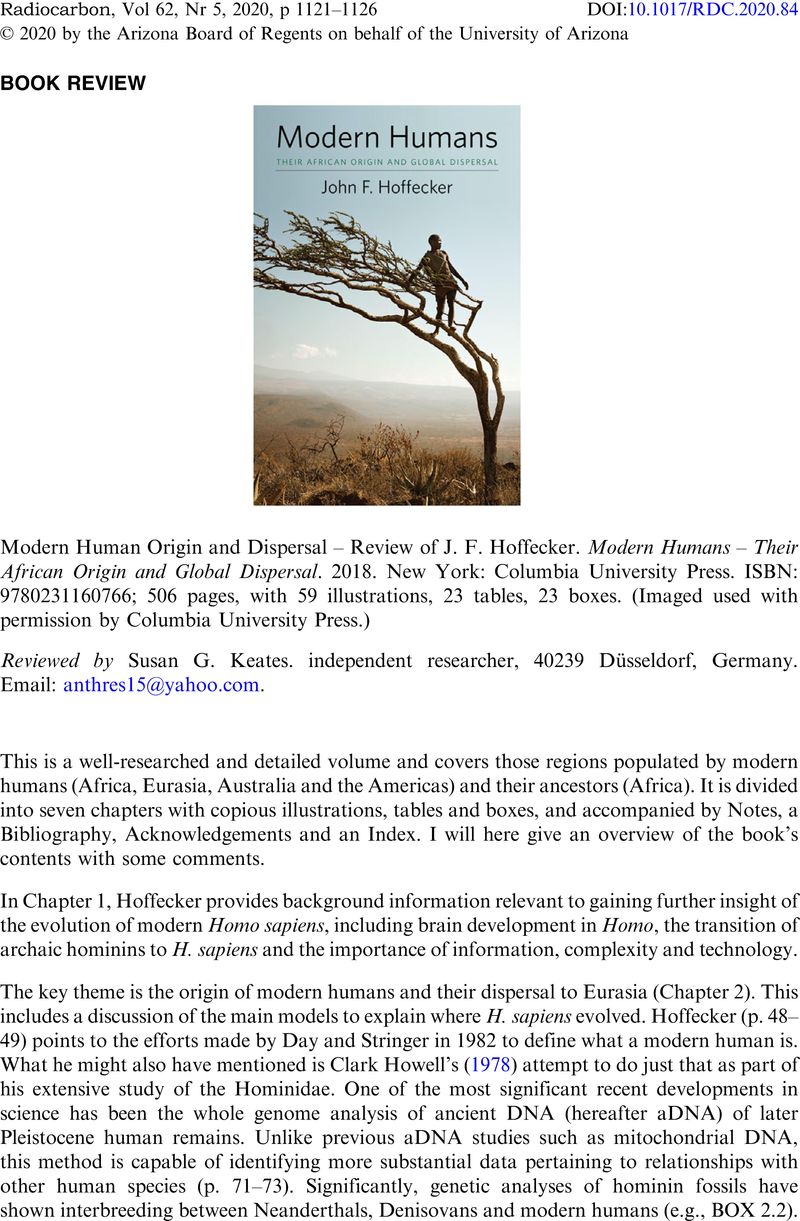No CrossRef data available.
Article contents
Modern Human Origin and Dispersal – Review of J. F. Hoffecker. Modern Humans – Their African Origin and Global Dispersal. 2018. New York: Columbia University Press. ISBN: 9780231160766; 506 pages, with 59 illustrations, 23 tables, 23 boxes. (Imaged used with permission by Columbia University Press.)
Published online by Cambridge University Press: 12 October 2020
Abstract
An abstract is not available for this content so a preview has been provided. Please use the Get access link above for information on how to access this content.

- Type
- Book Review
- Information
- Copyright
- © 2020 by the Arizona Board of Regents on behalf of the University of Arizona
References
REFERENCES
Blinkhorn, J, Ajithprasad, P, Mukherjee, A. 2017. Did modern human dispersal take a coastal route into India? New evidence from Palaeolithic surveys of Kachchh, Gujarat. Journal of Field Archaeology 42(3):198–213.CrossRefGoogle Scholar
Cadien, JD. 1972. Dental variation in Man. In: Washburn SL, Dolhinow P, editors. Perspectives on human evolution 2:199–222. New York: Holt, Rinehart and Winston.Google Scholar
Derevianko, AP, Molodin, IV. 1994. Denisova peschera. Chast 1 [Denisova Cave. Part 1]. Novosibirsk: Nauka. (In Russian with English summary). 262 p.Google Scholar
Derevianko, AP, Shunkov, MV, Volkov, PV. 2008. A Paleolithic bracelet from Denisova Cave. Archaeology, Ethnology & Anthropology of Eurasia 34(2):13–25.CrossRefGoogle Scholar
Frayer, DW, Wolpoff, MH, Thorne, AG, Smith, FH, Pope, GG. 1993. Theories of modern human origins: the paleontological test. American Anthropologist 95(1):14–50.CrossRefGoogle Scholar
Gao, X, Peng, F, Fu, QM, Li, F. 2017. New progress in understanding the origins of modern humans in China. Science China Earth Sciences 60:2160–70.CrossRefGoogle Scholar
Hawks, JD, Wolpoff, MH. 2001. The four faces of Eve: hypothesis compatibility and human origins. Quaternary International 75:41–50.CrossRefGoogle Scholar
Hedges, REM, Housley, RA, Law, IA, Bronk, CR. 1989. Radiocarbon dates from the Oxford AMS system: Archaeometry Datelist 9. Archaeometry 31:207–234.CrossRefGoogle Scholar
Howell, FC. 1978. Hominidae. In: Maglio, VJ, Cooke, HBS, editors. Evolution of African Mammals. Cambridge (MA): Harvard University Press. p. 154–248.Google Scholar
Jacobi, RM, Higham, TFG, Bronk Ramsey, C. 2006. AMS radiocarbon dating of Middle and Upper Palaeolithic bone in the British Isles: improved reliability using ultrafiltration. Journal of Quarternary Science 21:557–574.CrossRefGoogle Scholar
Kahlke, R-D. 1994. Die Entstehungs-, Entwicklungs- und Verbreitungsgeschichte des oberpleistozänen Mammuthus-Coelodonta-Faunenkomplexes in Eurasien (Großsäuger). Abhandlungen der Senckenbergischen Naturforschenden Gesellschaft 546. Frankfurt: Waldemar Kramer. 164 p.Google Scholar
Keates, SG. 2004. Notes on the Palaeolithic finds from the Walanae valley, southwest Sulawesi, in the context of the Late Pleistocene of Island Southeast Asia. In: Keates SG, Pasveer JM, editors. Quaternary research in Indonesia. Modern Quaternary Research in Southeast Asia 18:85–110. Leiden: A.A. Balkema Publishers.Google Scholar
Keates, SG. 2010. The chronology of Pleistocene modern humans in China, Korea, and Japan. Radiocarbon 52(23):428–465.CrossRefGoogle Scholar
Keates, SG, Hodgins, GWL, Kuzmin, YV, Orlova, LA. 2007. First direct dating of a presumed Pleistocene hominid from China: AMS radiocarbon age of a femur from the Ordos Plateau. Journal of Human Evolution 53:1–5.CrossRefGoogle ScholarPubMed
Keates, SG, Kuzmin, YV. 2015. Shuidonggou localities 1 and 2 in northern China: archaeology and chronology of the Initial Upper Palaeolithic in north-east Asia. Antiquity 89(345):714–720.CrossRefGoogle Scholar
Kuzmin, YV. 2008. Siberia at the Last Glacial Maximum: environment and archaeology. Journal of Archaeological Research 16:163–221.CrossRefGoogle Scholar
Kuzmin, YV, Keates, SG. 2005. Dates are not just data: Paleolithic settlement patterns in Siberia derived from radiocarbon records. American Antiquity 70(4):773–789.CrossRefGoogle Scholar
Kuzmin, YV, Keates, SG. 2018. Siberia and neighboring regions in the Last Glacial Maximum: did people occupy northern Eurasia at that time? Archaeological and Anthropological Sciences 10:111–114.CrossRefGoogle Scholar
Liu, W, Wu, X, Wang, S. 2006. Some problems for the Late Pleistocene human cranium found in Liujiang of South China based on morphological analysis. Acta Anthropologica Sinica 25(3):177–194. (In Chinese with English abstract).Google Scholar
Nakagawa, R, Doi, N, Nishioka, Y, Nunami, S, Yamauchi, H, Fujita, M, Yamazaki, S, Yamamoto, M, Katagiri, C, Mukai, H, Matsuzaki, H, Gakuhari, T, Takigami, M, Yoneda, M. 2010. Pleistocene human remains from the Shiraho-Saonetabaru Cave on Ishigaki Island, Okinawa, Japan, and their radiocarbon dating. Anthropological Science 118(1):173–183.CrossRefGoogle Scholar
Pope, GG. 1992. Craniofacial evidence for the origin of modern humans in China. Yearbook of Physical Anthropology 35:243–298.CrossRefGoogle Scholar
Shang, H, Wei, Q, Wu, X. 2006. An issue on the date of fossil human remains from Salawusu, Inner Mongolia. Acta Anthropologica Sinica 25:82–86. (In Chinese with English abstract).Google Scholar
Shen, GJ, Wang, W, Wang, Q, Zhao, J, Collerson, K, Zhou, C, Tobias, PV. 2002. U-series dating of Liujiang hominid site in Guangxi, Southern China. Journal of Human Evolution 43:817–829.CrossRefGoogle ScholarPubMed
Turner, CG II, Ovodov, ND, Pavlova, OV. 2013. Animal teeth and human tools: a taphonomic odyssey in Ice Age Siberia. Cambridge: Cambridge University Press. p. 490.CrossRefGoogle Scholar
Voris, HK. 2000. Maps of Pleistocene sea levels in Southeast Asia: shorelines, river systems and time durations. Journal of Biogeography 27:1153–1167.CrossRefGoogle Scholar
White, M, Pettitt, P. 2012. Ancient digs and modern myths: the age and context of the Kent’s Cavern 4 maxilla and the earliest Homo sapiens specimens in Europe. European Journal of Archaeology 15(3):392–420.CrossRefGoogle Scholar
Wu, X, Poirier, FE. 1995. Human evolution in China. Oxford: Oxford University Press. 317 p.Google Scholar
Yuan, S, Zhou, G, Guo, Z, Zhang, Z, Gao, S, Li, K, Wang, J, Liu, K, Li, B, Lu, X. 1995. 14C AMS dating the transition from the Paleolithic to the Neolithic in South China. Radiocarbon 37(2):245–249.CrossRefGoogle Scholar





